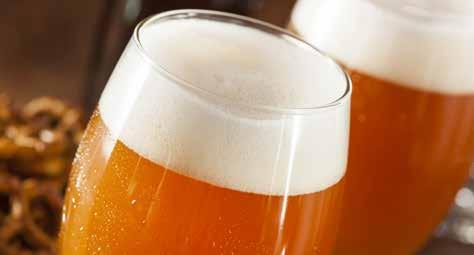
4 minute read
Belgian Beer Styles Beckon
Belgian Beer Styles Beckon BY DAVID NUTTALL
cursory glance of beer style names will show that most are identified by region. We have A
Advertisement
American lagers, British ales, German hefeweizens, Czech pilsners, etc. These designations were about as far as beer descriptors got until Michael James
Jackson's The World Guide To Beer was published in 1977. He categorized beers as more than colour, flavour, ABV, ingredients, and production methods, by identifying their history or origin and cultural significance to a locality.
When the American Homebrewers
Association (AHA) formed in 1978 and the Beer Judge Certification Program (BJCP) in 1985, they both developed style descriptors and guidelines for competitions and brewing specifications, most which reflect region of origin.
The country that most fascinated Jackson, but was largely ignored in North America, was Belgium. In 1980, this relatively small country of less than ten million people had several hundred breweries (compared to three national and eight independent breweries in Canada and about 80 breweries in the U.S.). However, since most of its beer came from small cottage operations, very little of it left Europe, as exemplified by the number of Belgian beers available on ALCB store shelves at the time (zero).
That does not mean their brands weren’t appreciated; beer aficionados the world over knew the quality and diversity of the country's output, which was part of Belgian beer's other obstacle to mass appeal, that diversification hurt Belgium’s identity to any distinct beer style(s); seemingly every brewery produced unique beers. Despite that, thanks to homebrewing clubs and savvy importers, a trickle of Belgian imports began to appear in North American liquor stores and restaurants by the mid 1990s, including Alberta. When New Belgium Brewing Company opened in 1991 in Colorado, and Unibroue in Quebec the following year, both essentially brewed Belgian style beers and craft brewing began to notice.
What makes many Belgian beer styles unique is the most overlooked ingredient
in beer - the yeast. While malts and hops draw all the acclaim, the yeast often only gets acknowledged for its utilitarian role in converting the sugars into CO2 and alcohol. However, it can also produce esters, phenols, and other compounds that can affect taste, aroma, and carbonation levels. Hence, some Belgian breweries have been guarding and cultivating their yeasts for centuries, making it almost impossible to copy their recipes.
Nonetheless, as craft brewing grew, its brewers began expanding their repertoire of recipes, and by the 2000s, many of them were producing their own versions of Belgian beer styles. The first and still most prominent style to appear was witbier (sometimes called wit). As a wheat beer with spices and citrus peel, it required ale yeast, so was an easy introduction for both brewers and beer drinkers.
Modern commercial yeast labs began in the 1980s, but really started to multiply in the 2010s as brewery numbers exploded. This allowed brewers access to the specialized yeast strains that defined Belgian beers, such as the saison. Made with its namesake yeast, it produces spicy/fruity characteristics that make it a favourite style to combine with fruit.
Belgian brewers also stand apart in their fondness for using multiple grains. While barley dominates the malt bill of most beers, Belgians commonly use any of wheat malt, unmalted wheat, oats, rye, maize, spelt, and adjuncts for their mash bill. In addition, Belgians aren’t afraid of adding substantial amounts of sugary compounds either. These are essential ingredients when making higher alcohol beers like the Belgian Blonde and Golden Strong Ales. This is also standard practice for what are commonly called the Monastic Ales; Dubbels, Tripels, Quads, and Dark Strongs. All employ high attenuating Abbey, Trappist, or Belgian Strong Ale yeasts to deliver beers that have a touch of sweetness to them while ranging from 6 to 12 percent ABV.
Over the past few years, the new Belgian darling has become the sour. Although it is technically a group of somewhat related beer styles, craft breweries tend to market them as any beer containing wild yeasts and/or bacteria; here you find Brettanomyces and Saccharomyces yeasts combining with bacterial strains such as Lactobacillus and Pediococcus. While craft breweries tended to use the kettle sour method of accelerated production originally, today many are also following the Belgian traditions of multi-year aging, storage in barrels, blending, and bottle conditioning. To that end, you can now find craft versions of Flanders Reds, Oud Bruins and Lambics, with or without fruit additions. Look also for other styles like Belgian Pale Ale, Gueuze, Bière de Garde, and Table Beer.
While proceeding through the third decade of the 21st century, we are bound to see more Belgian styles produced by your local craft breweries as once inaccessible ingredients become more attainable for brewers, and the public gets better educated about what Belgian beers bring to the table. Their popularity is growing, and brewers enjoy the challenge of creating individualized versions of centuries-old recipes. Well over half of Alberta’s 120+ breweries make some form of Belgian style beer, so next time you visit one, see what they have available and be prepared for something wonderfully different.


David has worked in liquor since the late 1980s. He is a freelance writer, beer judge, speaker, and since 2014, has run Brew Ed monthly beer education classes in Calgary. Follow @abfbrewed.










